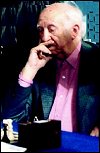Philidor
| Morphy | Tarrasch
| Lasker | Pillsbury
| Rubinstein | Niemzowitsch
| Capablanca | Reti
| Alekhine | Najdorf | Reshevsky
| Khan
. . . . . . . . . . . . . . . . . . . . . . . .
Miguel Najdorf
 GM Miguel Najdorf was a flamboyant poet of the chess pieces who was one
of the most celebrated grandmasters never to play for the world championship.
GM Miguel Najdorf was a flamboyant poet of the chess pieces who was one
of the most celebrated grandmasters never to play for the world championship.
GM Najdorf is perhaps best known for the opening variation that carries his name, the popular Najdorf variation of the Sicilian Defense. The formation, championed by Bobby Fischer and Garry Kasparov among others, arises after 1 e4 c5 2 Nf3 d6 3 d4 cd 4 Nd4 Nf6 5 Nc3 a6. He also played the famous Polish Immortal Game in 1935, which went around the world. In that game, he sacrificed all of his minor pieces.
'It is one of the most hotly contested methods of starting games today,' said GM Robert Byrne, the chess columnist for The New York Times. 'It is aggressive, adventurous and capable of turning the tables with little warning.'
GM Najdorf (pronounced NIGH-dorf), who was born in Warsaw, Poland and began playing chess at age 12, traveled to Buenos Aires in 1939 with the Polish national team for a tournament. Two weeks after he arrived, Germany invaded Poland. You can probably guess what happened nextŠ
Unable to return safely to his family in Poland, Najdorf, who was Jewish, stayed on in Argentina. He thereby escaped the Holocaust, but he lost his wife, child, father, mother and four brothers in concentration camps.
In the 1940's, GM Najdorf gave an exhibition of blindfold play, or play without sight of the board. He took on 45 players at one time, carrying all the games simultaneously in his head. He won 39, drew 4 and lost 2. In 1972, he recalled in an interview: 'I did this not as a stunt. I hoped that this exhibition would be reported throughout Germany, Poland and Russia and that some of my family might read about it and get in touch with me.' But none did so.
When Najdorf died on July 4 in 1997 at the Malaga University Hospital in Malaga, Spain, he was 87 and was survived by his second wife, Rita, and daughter Mirta Najdorf. The cause of death was complications from surgery. He had been staying at a hotel in the Spanish resort Marbella and underwent the surgery on July 4th.
GM Najdorf became an Argentine citizen in 1944 and went on to be a leading tournament contender after the end of the war, a status he held for more than 20 years.
Though he never managed to qualify for a championship match, he compiled an impressive record. He won 52 international tournaments; he won the Argentine chess championship eight times; he repeatedly headed the Argentine national chess team, and in 1948 he was considered one of the world's 10 best players. He was also a longtime chess writer.
GM Najdorf, a short dapper man with a big voice, was a delight to spectators because of his imaginative attacking games. He was also a high-strung competitor with the odd habit of buttonholing other players in the tournament room, while his opponent was thinking, and asking them, 'How do I stand?'
Of course, it is against the rules to solicit others' opinions during a game, but GM Najdorf was never challenged. On one occasion, however, the player he questioned simply stood there, shy and speechless: GM Najdorf had absentmindedly addressed his opponent in that day's game, the noted Soviet chess theoretician GM Isaac Boleslavsky.
Although Najdorf is credited with inventing the Najdorf defense, others may have got there first. 'He did most of the creative development of it,' GM Robert Byrne said, 'but he was anticipated by various Czechoslovak masters, particularly Karel Opocensky. That is not unusual in chess, where the flowering of an idea often outweighs its origin.'
GM Najdorf is said to have been one of the world's richest chess players, not from chess but from business, as a representative of insurance and finance companies.
He loved to play friendly games with people far more famous than he, including Fidel Castro, Winston Churchill, Che Guevara, Nikita Khrushchev, the Shah of Iran and Juan Peron.
GM Najdorf also exchanged letters with a passionate chess player in Rome. As a result, Argentine fans who followed the Najdorf column in the Buenos Aires newspaper Clarin were able to ponder a chess problem contributed by the enthusiast in Rome, Pope John Paul II.
-----Terry Crandall
. . . . . . . . . . . . . . . . . . . . . . . .
Philidor | Morphy | Tarrasch | Lasker | Pillsbury | Rubinstein | Niemzowitsch | Capablanca | Reti | Alekhine | Najdorf | Reshevsky | Khan